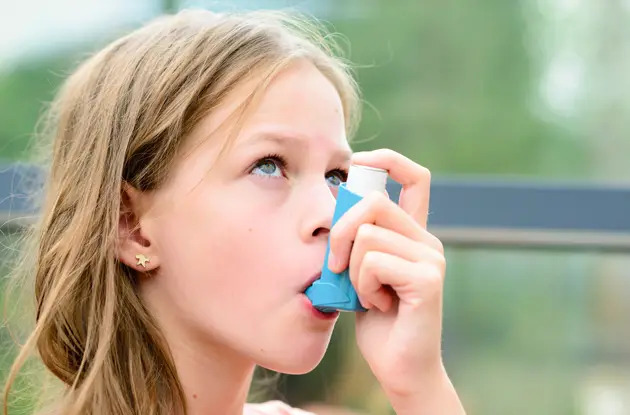We spoke to an asthma and allergy specialist to find out how to manage and control your child’s asthma, how to prevent asthma attacks, and reducing asthma triggers.
Asthma is a serious health issue that plagues many children as well as adults. Atul Shah, M.D., FACAAI, FAAAAI, Medical Director of Center for Asthma and Allergy, explains the basics of asthma and how to know when it’s serious. “By definition, asthma is a chronic condition that is very common in children,” Dr. Shah explains, with 1 in 10 kids in America having some form of asthma. Of these kids, 3 in 5 will have an asthma attack in their life. Therefore, it is very important for parents to know when taking care of a child with asthma.
What is Asthma?
Asthma can range from moderate to severe, depending on the frequency of symptoms. Children with mild asthma have symptoms that come and go, while a child with severe asthma requires frequent monitoring and has symptoms daily. When a child has symptoms of asthma, the airway goes into spasm, so the small airways in the lungs become smaller and there is less ability of oxygen to flow through. This affects how much oxygen gets to the rest of the organs in the body, which can cause severe consequences.
Signs and symptoms of asthma include:
|
If a child presents with these symptoms, parents should consider bringing him to his primary care provider or a specialist to determine whether he has asthma.
How to Manage Asthma
If a child is diagnosed with asthma, it may be chronic or more severe if it is not controlled properly. If a child wakes up two or more nights during the month because of asthma, if she needs her rescue inhaler two to three times per week, or if she uses more than one inhaler in a three-month period, she should be evaluated to find a way to better control her asthma. If a child cannot play because of his asthma, he should also be seen to determine if it could be better controlled. As Dr. Shah says, the goal for any asthma patient is the best quality of life with minimal medication, which can only be achieved with the proper medication regimen administered on a consistent basis.
What Can Cause an Asthma Attack?
Since asthma attacks are relatively common, even parents of children with mild asthma should be prepared. An asthma attack is usually brought on by either an allergy trigger or non-allergy trigger. According to Dr. Shah, 4 out of 5 children with asthma have underlying allergies, which can be indoor, outdoor, or food allergies. Indoor allergies include those to dogs, cats, and dust mites. Outdoor allergies include tree pollen, grass pollen, ragweed, wheat pollen, and outdoor mold.
The most common non-allergy trigger in children is respiratory infection, along with ear infections, strep throat, sinus infections, and bronchitis. Also, strong smells (such as bathroom cleaners, cigarette smoke, and candles), changes in temperature (extreme hot or cold), and high humidity are all non-allergy triggers that can induce an asthma attack. Physical activity can also be a non-allergy trigger for children and can include exercise, giggling, laughing, excessive crying, or screaming. These can result in an asthma exacerbation, or worsening of asthma symptoms in a child, which can ultimately result in an asthma attack.
Reducing Asthma Triggers
According to Dr. Shah, the most important thing to help control a child’s asthma and preventing attacks is identifying her triggers. Then, it is important for parents to help the child avoid those triggers. Parents can do this by helping control their child’s environment. For example, if dogs or cats are triggers, they should not be allowed in the child’s bedroom and the pets should be bathed once a week to reduce dander. To prevent triggers from dust mites, parents can buy covers for the child’s blankets and pillows. It is also important to control humidity and flooding to prevent mold, if that is a trigger for the child. Overall, parents must make specific accommodations based on each child’s individual allergies and consequent triggers. If the allergy is very severe, children can receive allergy drops or allergy shots to desensitize them to the trigger and reduce the need for their asthma medications.
Asthma Attack: What Parents Need To Know
When a child is exposed to any of his asthma triggers, it can induce an asthma attack, or exacerbation. He often will have a constant cough (so severe it may cause him to vomit), shortness of breath, complaints of chest tightness, and wheezing. However, Dr. Shah emphasized that the absence of wheezing does not mean that the child is not having an asthma attack—sometimes the airway is so tight that the wheeze is inaudible. The child also might not be able to speak in full sentences because she is so short of breath and will only be able to speak in phrases. She might not be able to lie down because she cannot breathe, and may be in a hunched-shoulder position, using neck and chest muscles to breathe, which she normally wouldn’t. If his lips turn blue, he gets very confused or agitated, or even looses a sense of consciousness, parents must seek further medical attention.
If a child presents with any of these symptoms, parents should first provide her with her rescue medication—whether it be a rescue inhaler or nebulizer. This should resolve the child’s symptoms, or at least make her feel better within 15-30 minutes. If she does not improve or gets worse, parents should seek immediate medical attention.
Controlling and Preventing Asthma Attacks
Parents should be prepared to handle minor asthma exacerbations at home with rescue medication in the form of an inhaler or nebulizer. Parents should also monitor their child’s asthma at home with a peak flow meter, a small, inexpensive plastic device that helps monitor a child’s breathing. It provides the parent with numbers that correlate with the child’s lung function and can help parents be proactive in preventing asthma attacks. For example, each child has his or her own “best numbers,” according to Dr. Shah. If their current numbers are 60 percent or less of their best numbers, it is a sign of a severe asthma attack. Therefore, parents who monitor their child’s numbers regularly can determine if their child is at risk for an attack before it happens.
Overall, it is important for each parent to know the specifics about their child’s asthma and allergies in order to prevent worsening symptoms and a severe attack.
RELATED: Find Asthma and Allergy Specialists Near You





















